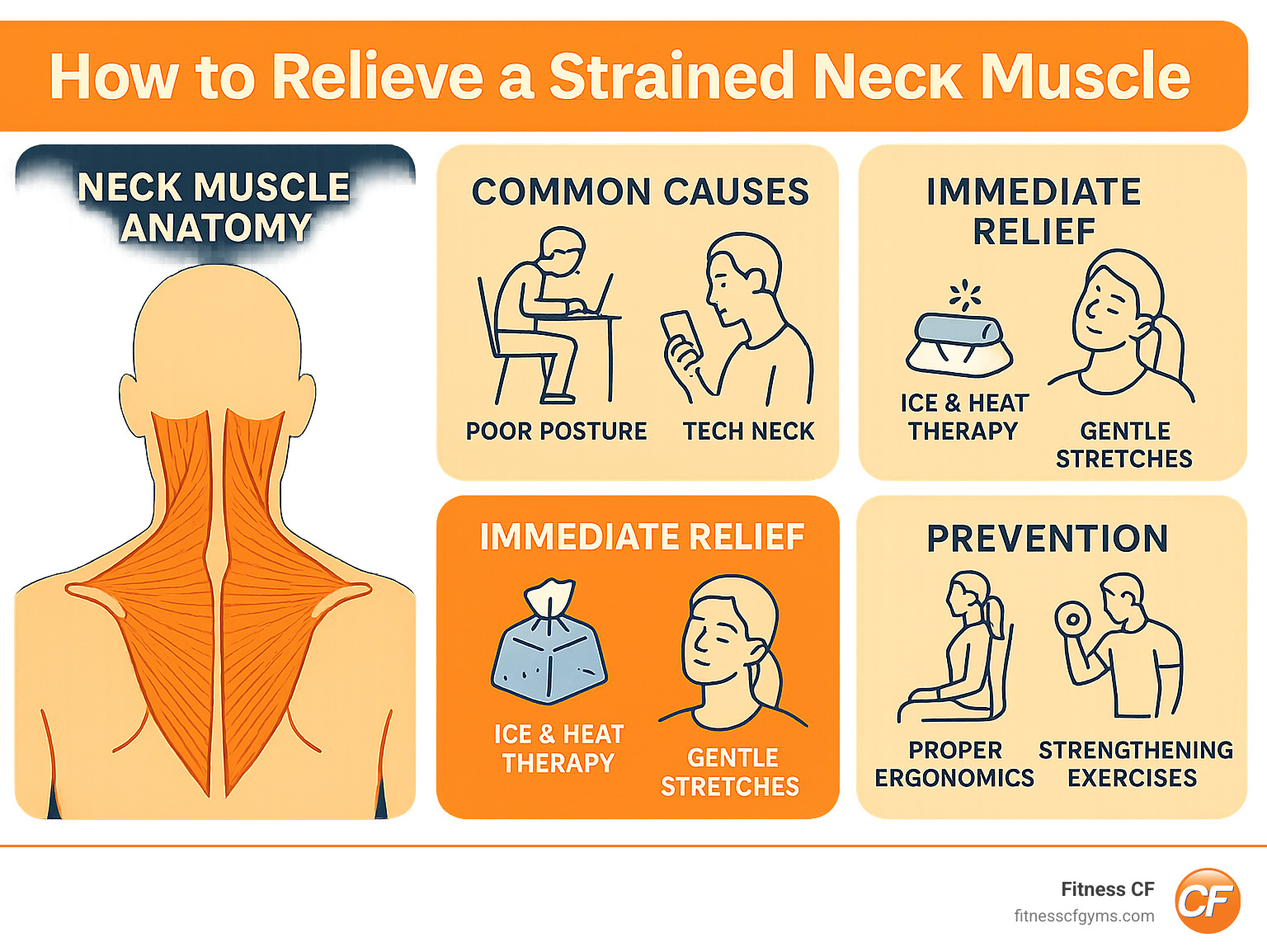Unlock Your Neck: Stretches and Soothing Tips for Muscle Relief

Why Neck Strain Is So Common (And How Relief Is Possible)
How to relieve a strained neck muscle involves immediate care with ice therapy, gentle stretches, and over-the-counter pain relief, followed by gradual movement and strengthening exercises to prevent future injury.
Quick Relief Steps:
- Ice therapy – Apply for 15-20 minutes every few hours for first 48 hours
- Pain medication – Take ibuprofen or acetaminophen as directed
- Gentle stretches – Start with slow neck rotations and side bends
- Heat therapy – Switch to warm compresses after 48 hours
- Stay active – Avoid bed rest; keep moving within pain limits
Nearly one in three people suffer from neck pain, making it one of the most common complaints we see today. Whether you wake up with a “crick” in your neck or develop pain from hours hunched over a computer, neck strain affects busy professionals and active individuals alike.
The good news? Most mild to moderate neck pain responds well to simple home care within two to three weeks. Your neck muscles are designed to support your head – which weighs about as much as a bowling ball – so they’re actually quite resilient when given proper care.
Regular strength training helps build the supporting muscles around your neck and shoulders, while cardiovascular exercise improves blood flow to promote healing. A well-rounded fitness routine creates the foundation for a healthy, pain-free neck.
As Pleasant Lewis, with over 40 years in the fitness industry, I’ve helped countless members learn how to relieve a strained neck muscle through proper movement and strengthening techniques. My experience has shown that combining immediate relief strategies with long-term fitness habits creates the best outcomes for lasting neck health.

Understanding Neck Strain: Causes and Symptoms
A neck strain occurs when muscle fibers are overstretched or torn, much like an overstretched rubber band. This can range from minor Grade I strains with microscopic tears to more significant Grade II strains with partial tearing. Thankfully, severe Grade III ruptures are rare and usually result from major trauma.
Surprisingly, everyday activities are often the culprit. Poor posture is a primary cause, especially when spending hours with your head forward and shoulders rounded. This position dramatically increases the load on your neck muscles. Regular strength training for the upper back and neck is key to counteracting these postural stresses.
Tech neck, a modern result of constantly looking down at smartphones, adds significant repetitive strain. Other common causes include sleeping in awkward positions, sudden movements like whiplash, and overexertion during exercise, particularly without a proper warm-up.
When a neck strain occurs, the symptoms are hard to miss:
- Localized pain, ranging from a dull ache to sharp, stabbing sensations with movement.
- Stiffness that makes turning your head difficult.
- Muscle spasms, which feel like your neck is locking up.
- Tension headaches that often start at the base of the skull.
- Reduced range of motion, limiting your ability to move your head freely.
Consistent cardiovascular exercise like walking or swimming improves blood flow to neck muscles, while regular movement helps prevent the stiffness that can lead to a strain. Building overall fitness is crucial for supporting your neck’s daily demands, as prevention is always the best strategy.
How to Relieve a Strained Neck Muscle with Immediate Home Care
When that sharp pain hits your neck, your first instinct might be to panic or immediately reach for the strongest pain medication you can find. Take a deep breath – how to relieve a strained neck muscle starts with simple, gentle care that you can do right at home.
The first 48 to 72 hours are absolutely critical for your recovery. Think of this time as your body’s natural healing window, where the right care can make the difference between a quick recovery and weeks of lingering discomfort. Your immediate response focuses on two main goals: managing pain and reducing inflammation.

Hot and Cold Therapy
Here’s where many people get confused – should you use ice or heat? The answer depends on timing, and getting this right can dramatically speed up your recovery.
Ice is your go-to for the first 48 hours. When you first strain your neck muscle, tiny tears in the muscle fibers trigger inflammation. Ice works like a natural anti-inflammatory, constricting blood vessels and reducing swelling. Wrap an ice pack in a thin towel (never apply ice directly to your skin) and apply it for 20-minute intervals throughout the day.
After those crucial first 48 hours, it’s time to switch to heat therapy. Now your body needs increased blood flow to deliver healing nutrients to the damaged tissue. Heat relaxes tight muscles and opens up blood vessels, promoting faster recovery. Warm showers can feel incredibly soothing, or you can use heating pads set on low to medium heat.
Many people find that alternating between heat and cold after the initial 48-hour period works wonders. Try 20 minutes of heat followed by 20 minutes of cold, repeating this cycle several times throughout the day. This contrast therapy can provide comprehensive relief that targets both muscle tension and lingering inflammation.
Over-the-Counter Pain Relief
While your body has amazing natural healing abilities, sometimes it needs a little help managing pain and inflammation. Over-the-counter medications can be incredibly effective when used properly.
NSAIDs like ibuprofen and naproxen are particularly helpful because they tackle both pain and inflammation simultaneously. These medications work by blocking the enzymes that cause inflammation, giving your body a chance to heal without the constant pain signals interfering with recovery.
Acetaminophen focuses primarily on pain reduction rather than inflammation. It’s an excellent choice if you can’t take NSAIDs due to stomach sensitivity or other health conditions. Always follow the dosage instructions on the package, and don’t hesitate to consult with a pharmacist if you’re unsure about interactions with other medications you might be taking.
For more detailed information about treatment approaches, How Do You Treat a Strained Neck Muscle? provides additional medical insights that can help guide your recovery.
Gentle Massage and Self-Care Techniques
Your hands can be powerful healing tools when it comes to neck strain relief. Self-massage techniques don’t require any special training – just gentle, intuitive movements that feel good to your body.
Using your fingertips, apply gentle pressure to the sore areas around your neck and shoulders. Move in small circles, gradually working from the base of your skull down toward your shoulders. Improving blood flow through massage helps deliver fresh oxygen and nutrients to the healing tissues while carrying away waste products that can contribute to pain.
The beauty of massage goes beyond just the physical benefits. It triggers your body’s endorphin release – those natural “feel-good” chemicals that act as your body’s own pain medication. Even five to ten minutes of gentle self-massage can provide noticeable relief.
Relaxation methods play a crucial role in recovery that many people overlook. When you’re in pain, your entire body tends to tense up, creating a cycle where stress makes pain worse, and pain increases stress. Simple deep breathing exercises can help break this cycle. Try breathing in slowly for four counts, holding for four counts, then exhaling for six counts.
Muscle recovery isn’t just about treating the immediate injury – it’s about supporting your body’s overall healing process. For broader insights into muscle care, check out What are the best ways to relieve sore muscles? for additional recovery strategies that complement your neck-specific care routine.
Active Recovery: Stretches and Strengthening Exercises
Lasting recovery from neck strain requires gentle, purposeful movement, not prolonged stillness. Once the initial sharp pain subsides (usually after 48-72 hours), you can begin active recovery. This approach, similar to Active recovery for athletes, involves encouraging healing without overexertion. If any movement increases pain, back off and try again later.

Gentle Stretches to Restore Mobility
These stretches gently encourage your muscles to relax and lengthen. Hold each for 15-30 seconds and repeat 2-4 times.
- Neck Rotations: Sit straight and slowly turn your head to one side until you feel a gentle stretch. Return to center and repeat on the other side.
- Lateral Bends: Tip your right ear toward your right shoulder, keeping shoulders relaxed. Switch sides.
- Forward Flexion: Slowly bring your chin toward your chest, avoiding hunching your shoulders.
- Levator Scapula Stretch: For pain near the shoulder blade, tilt your head to one shoulder, then turn to look down into that armpit. You’ll feel the stretch on the opposite side.
- Chin Tucks: Gently draw your chin back as if giving a subtle nod to counteract forward head posture.
For more ideas, explore these Stretching routines to improve flexibility and prevent injuries or specific exercises from Neck Spasm: Exercises | Kaiser Permanente.
How to Relieve a Strained Neck Muscle with Strengthening
Once the pain has significantly decreased, building strength is key to preventing future problems.
- Isometric Exercises: Build strength without movement. Place your palm on your forehead and press forward while resisting with your hand, holding for 6 seconds. Repeat 8-12 times. Do the same pressing backward and to each side.
- Upper Back Strengthening: Strong back muscles support the neck. Squeeze your shoulder blades together or perform seated rows.
- Core Stability: A strong core provides a foundation for good posture, reducing the strain on your neck.
Strength training builds resilience against future injuries. Learn more about What is strength training and what are its benefits? to understand how it creates a cascade of positive health effects.
The Role of Overall Fitness
Cardiovascular exercise is a powerful healing tool. Activities like walking or swimming boost circulation, delivering oxygen and nutrients to healing tissues. Swimming is especially beneficial as the water supports your body weight, allowing for gentle, full-range motion.
Relieving a strained neck muscle is about creating overall strength, flexibility, and cardiovascular health. A fit body has more resources for healing and maintenance. Regular exercise also serves as a natural stress reliever, breaking the cycle of tension that contributes to neck pain. For more on this holistic approach, see The best recovery practices after a tough workout. Building a resilient body is the best defense against future neck strain.
Building Resilience: Preventing Future Neck Strain
Once you’ve successfully learned how to relieve a strained neck muscle, the real work begins – building a foundation that prevents future problems. Think of this as investing in your long-term neck health rather than just treating symptoms as they arise.
The truth is, most neck strains are preventable through simple lifestyle changes and proactive measures. After helping thousands of members over my four decades in fitness, I’ve seen that people who focus on prevention rarely deal with recurring neck issues.

Mastering Your Posture and Ergonomics
Poor posture is the silent enemy of neck health, especially in our screen-dominated world. Every time you tilt your head down to check your phone, you’re adding up to 60 pounds of pressure on your cervical spine – that’s like carrying a small child on your neck all day.
“Tech neck” has become so common that we see it in teenagers now. The good news? Small adjustments to your workspace can make a huge difference.
Position your computer monitor so the top of the screen sits at eye level. This simple change eliminates the need to crane your neck forward or look down for hours. When using your phone, bring it up to eye level instead of dropping your head down to meet it.
Invest in ergonomic support that works with your body’s natural alignment. A good chair should support the natural curve of your spine, allowing your feet to rest flat on the floor. Your shoulders should sit directly over your hips, not hunched forward.
Set up your desk workspace thoughtfully. Use a document holder to keep papers at eye level, and if you’re frequently on calls, a headset prevents that awkward phone-shoulder cradle that wreaks havoc on neck muscles.
Remember to take movement breaks every hour or two. Even 30 seconds of gentle neck rolls and shoulder shrugs can reset your posture and relieve building tension. Understanding these factors helps prevent the issues that lead to a stiff neck.
How to Relieve a Strained Neck Muscle Through Lifestyle Adjustments
Beyond your workspace, several lifestyle changes create a strong foundation for neck health. These adjustments work together to support your body’s natural healing and strengthening processes.
Sleep posture plays a huge role in neck health since you spend about a third of your life in bed. A firm mattress paired with a supportive pillow maintains your neck’s natural curve while you sleep. Some people find relief with specially designed neck pillows, while others prefer a small rolled towel placed under the neck (not the head) for targeted support.
Stress management is often overlooked but incredibly important. Stress creates physical tension that settles in your neck and shoulders like an unwelcome guest. Regular activities like yoga, meditation, or even simple deep breathing exercises help release this tension before it builds into pain.
Cardiovascular exercise improves blood flow throughout your body, delivering nutrients to your neck muscles and promoting faster healing. Activities like walking, swimming, or cycling also release endorphins – your body’s natural stress relievers.
Strength training builds the supporting muscles around your neck and shoulders, creating a protective network that prevents strain. When your upper back, shoulders, and core are strong, they take pressure off your neck muscles during daily activities.
Proper warm-up and cool-down routines prepare your muscles for activity and help them recover afterward. This prevents the stiffness that can lead to compensatory movements and strain. Our comprehensive guide on The importance of warm-up and cool-down exercises: A comprehensive guide covers these essential practices in detail.
Maintaining a healthy weight reduces overall stress on your musculoskeletal system, while staying hydrated keeps your muscles and connective tissues functioning optimally. Even small lifestyle changes like taking the stairs or parking farther away add up to better overall fitness and neck health.
The key is consistency rather than perfection. Small, sustainable changes in how you move, work, and care for your body create lasting protection against future neck strain.
When to Seek Professional Help
While how to relieve a strained neck muscle at home works well for most people, there comes a point where self-care has its limits. Sometimes our bodies are telling us we need more than ice packs and gentle stretches – and that’s completely okay.
Most neck strains improve within two to three weeks with consistent home care. But if your pain feels more intense than usual, lingers for weeks without improvement, or comes with symptoms that make you worried, it’s time to reach out to a healthcare professional. Think of it as getting backup when you need it most.
Your body has ways of signaling when something needs professional attention. Ignoring these red flag symptoms can sometimes lead to complications that take much longer to resolve. The key is knowing what to watch for and trusting your instincts when something doesn’t feel right.
Warning Signs for a Doctor’s Visit
Pain that persists over a week despite consistent self-care is often the first sign you might need professional help. If you’ve been diligent with ice, heat, gentle stretches, and over-the-counter pain relief but aren’t seeing improvement, your neck strain might need a different approach.
Numbness or tingling in your arms or hands is particularly important to pay attention to. This sensation often indicates that nerves are being affected or compressed, which goes beyond a simple muscle strain. Similarly, any weakness in your limbs – especially new weakness in your arms or legs – warrants immediate medical attention.
If your neck pain resulted from a severe injury from a fall, car accident, or sports mishap, don’t wait to see if it gets better on its own. Trauma-related neck pain can involve more than just strained muscles and needs proper evaluation.
Some symptoms require urgent medical care. Loss of bladder or bowel control is a medical emergency that requires immediate attention. Difficulty walking or maintaining balance is another serious warning sign that shouldn’t be ignored.
Pay attention to how your pain behaves throughout the day and night. Pain that worsens when lying down or consistently wakes you from sleep often indicates something more complex than a typical muscle strain. Your body should find relief in rest, not increased discomfort.
Finally, pain accompanied by fever, chills, or unexplained weight loss could signal an underlying infection or other systemic issue that extends far beyond a simple neck strain.
A healthcare provider might recommend a soft neck collar for short-term relief, though these should only be used for one to two weeks and no more than three hours at a time. Longer use can actually weaken your neck muscles, working against your recovery goals.
Physical therapy can be incredibly beneficial for persistent neck issues. A skilled therapist can teach you proper posture techniques, alignment principles, and specific strengthening exercises custom to your unique needs. They become your personal guide for safely and effectively learning how to relieve a strained neck muscle while building long-term resilience.
Conclusion
Learning how to relieve a strained neck muscle is really about understanding your body’s needs and responding with the right care at the right time. We’ve walked through the essential steps together – from that crucial first response with ice therapy and pain relief, to the gentle stretches that restore your mobility, and finally to the strengthening exercises that build lasting resilience.
The beauty of this approach is how it mirrors what makes us stronger in all areas of life. Just like strength training teaches us to handle heavier loads gradually, recovering from neck strain is about progressive improvement. You start with gentle movements and slowly build back your strength and flexibility.
Cardiovascular exercise plays a wonderful supporting role too. When your heart pumps efficiently and your blood flows freely, every muscle in your body – including those hardworking neck muscles – gets the nutrients and oxygen needed for healing and maintenance.
But here’s what I’ve learned after four decades in fitness: the real magic happens when you accept overall wellness as a lifestyle. Regular movement, proper posture, stress management, and yes, even quality sleep all work together to keep your neck happy and healthy.
At Fitness CF, we see this holistic approach work every day. Members who commit to consistent fitness routines – combining strength work with cardio and flexibility training – simply experience fewer aches and pains. They move through life with more confidence and less worry about those nagging muscle strains.
Your body is designed to move, heal, and adapt. Give it the right tools through proper care and regular exercise, and it will reward you with years of comfortable, pain-free movement.
And when you’re ready to treat those hardworking muscles to some extra TLC, don’t forget about our HydroMassage services. There’s nothing quite like the soothing warmth of water massage to help your muscles relax and recover after a great workout or a long day.





